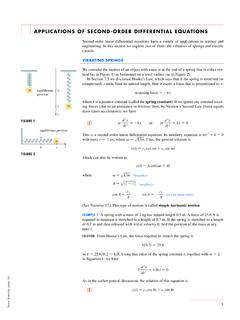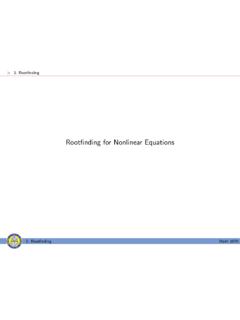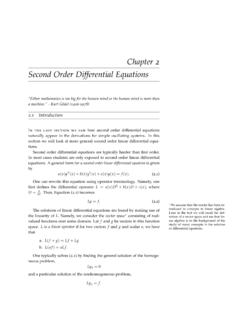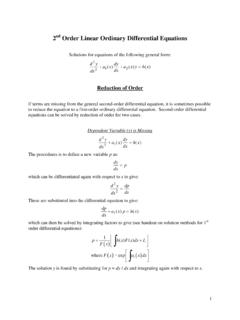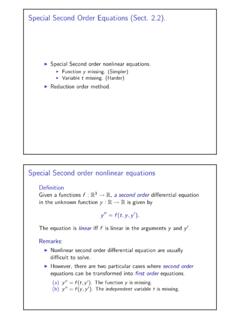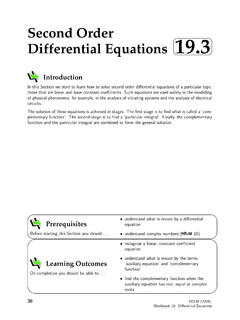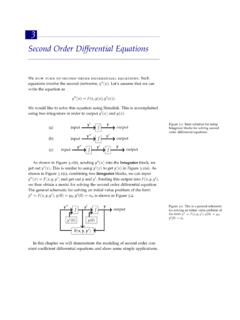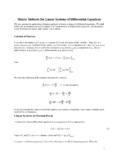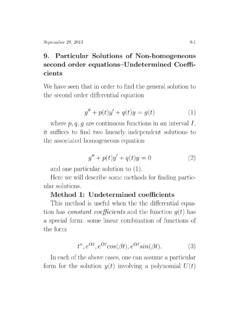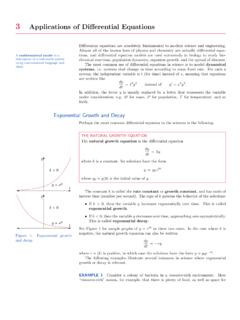Transcription of Nonhomogeneous Second-Order Differential Equations
1 Nonhomogeneous Second-Order Differential EquationsTo solveay +by +cy=f(x) we first consider the solution of the formy=yc+ypwhereycsolves the differential equaitonay +by +cy= 0 andypsolves the differential equationay +by +cy=f(x).Since the derivative of the sum equals the sum of the derivatives, we will have a finalsolution of 0 +f(x) which givesf(x).Therefore, we follow a pattern forypto yieldf(x) when each ofy,y andy are substi-tuted into the above Case I: Iff(x) is of the formf(x) =P(x)ekxthen we set:yp=Q(x)ekxwhereQ(x) is the general polynomial of the same degree asP(x).For example if the differential equation is set equal to:(a)f(x) =x2e3x. Setyp= (Ax2+Bx+C)e3x.(b)f(x) =x3 4x+ 1. Setyp=Ax3+Bx2+Cx+D.(c)f(x) = 6e 2x. Setyp=Ae we substituteyp,y p, andy pand solve for the Case II: Iff(x) is of the formf(x) =P(x)ekxsin (mx) orf(x) =P(x)ekxcos (mx),then we set:yp=Q(x)ekxcos (mx) +R(x)ekxsin (mx) whereQ(x) andR(x) are both generalpolynomials of the same degree asP(x).
2 For example if the differential equation is set equal to:(a)f(x) = 2 cos (3x). Setyp=Acos (3x) +Bsin (3x)(b)f(x) =xcos (x). Setyp= (Ax+B) cos (x) + (Cx+D) sin (x)(c)f(x) =exsin (2x). Setyp=Aexsin (2x) +Bexcos (2x)Iff(x) is a sum of terms, likef(x) =x2+e x+cos (x), do it as separate problems solvingforyp1=Ax2+Bx+C,yp2=Ae xandyp3=Acos (x) +Bsin (x). + 2y +y= 3 cos (2x),y(0) = 0,y (0) = 1y=yc+ypr2+ 2r+ 1 = 1. Thereforeyc=Me x+Nxe x(hold until end).Now to determineyp, consider the form:yp=Acos (2x) +Bsin (2x). Then differentiating givesy p= 2 Asin (2x) + 2 Bcos (2x)y p= 4 Acos (2x) 4 Bsin (2x).Substituting gives: 4 Acos (2x) 4 Bsin (2x) 4 Asin (2x) + 4 Bcos (2x) +Acos (2x) +Bsin (2x) =3 cos (2x)So that: 4A+ 4B+A= 3 and 4B 4A+B= 0 The system of Equations givesA= 925andB= DONE: We now havey=Me x+Nxe x 925cos (2x) +1225sin (2x)Substituting the initial conditions givesM=925andN=1025.
3 DONEy=925e x+1025xe x 925cos (2x) +1225sin (2x) + 4y=x2e x,y(0) = 0,y (0) = 1y=yc+ypr2+ 4 = 2i. Thereforeyc=Mcos (2x) +Nsin (2x) (hold until end).Now to determineyp, consider the form:yp= (Ax2+Bx+C)e x. Then differentiating givesy p= (2Ax+B)e x (Ax2+Bx+C)e xy p= 2Ae x (2Ax+B)e x (2Ax+B)e x+ (Ax2+Bx+C)e gives:2Ae x 4 Axe x 2Be x+Ax2e x+Bxe x+Ce x+4Ax2e x+4 Bxe x+4Ce x=x2e xGather and group quadratic, linear and constant terms to have: 5A= 1, whichgivesA=15. 4A+B+ 4B= 0 45+ 5B= 0 B= 2B+C+ 4C= 0 25 825+ 5C= 0 C= 2125 NOT DONE: We now have:y=Mcos (2x) +Nsin (2x) +(15x2+45x 2125)e xSubstituting the initial conditions givesM=2125andN=27250. DONE !y=2125cos (2x) +27250sin (2x) +(15x2+45x 2125)e x
